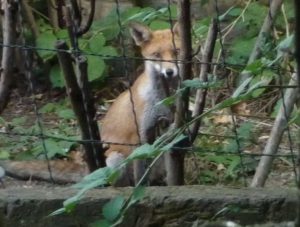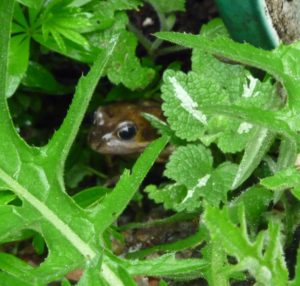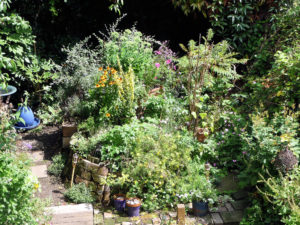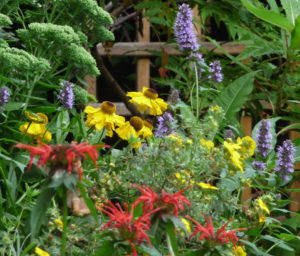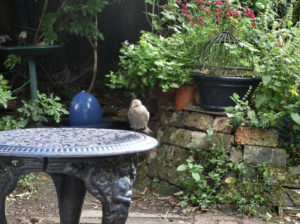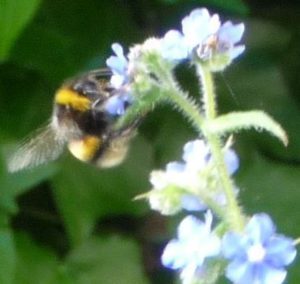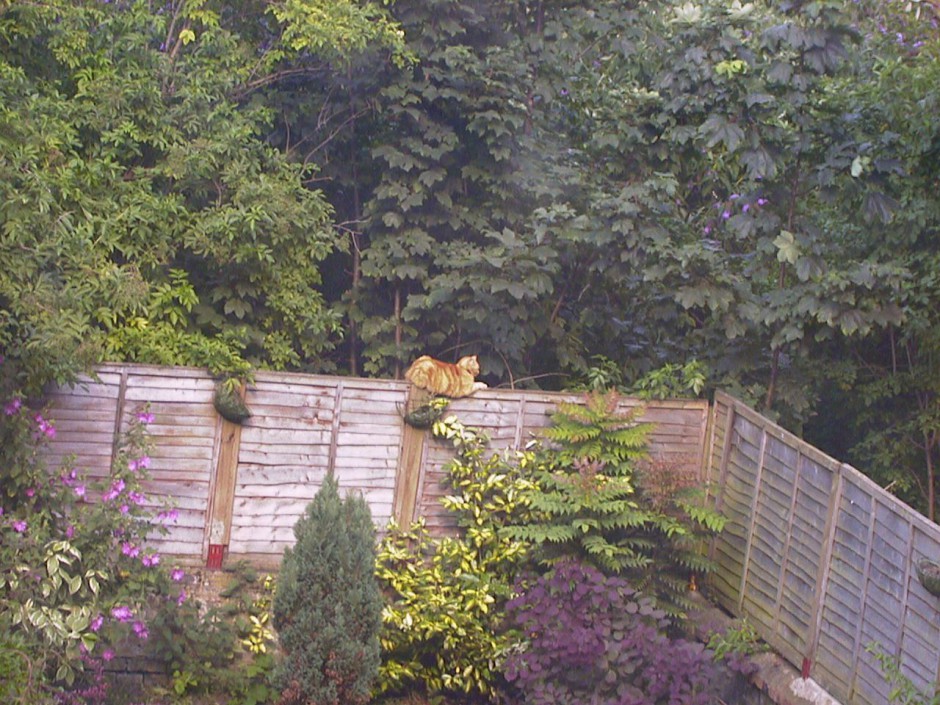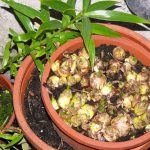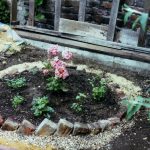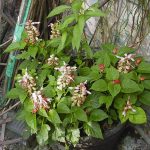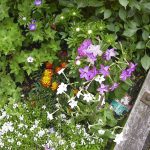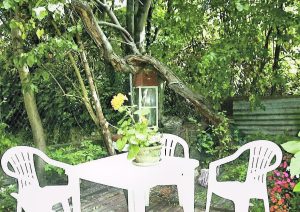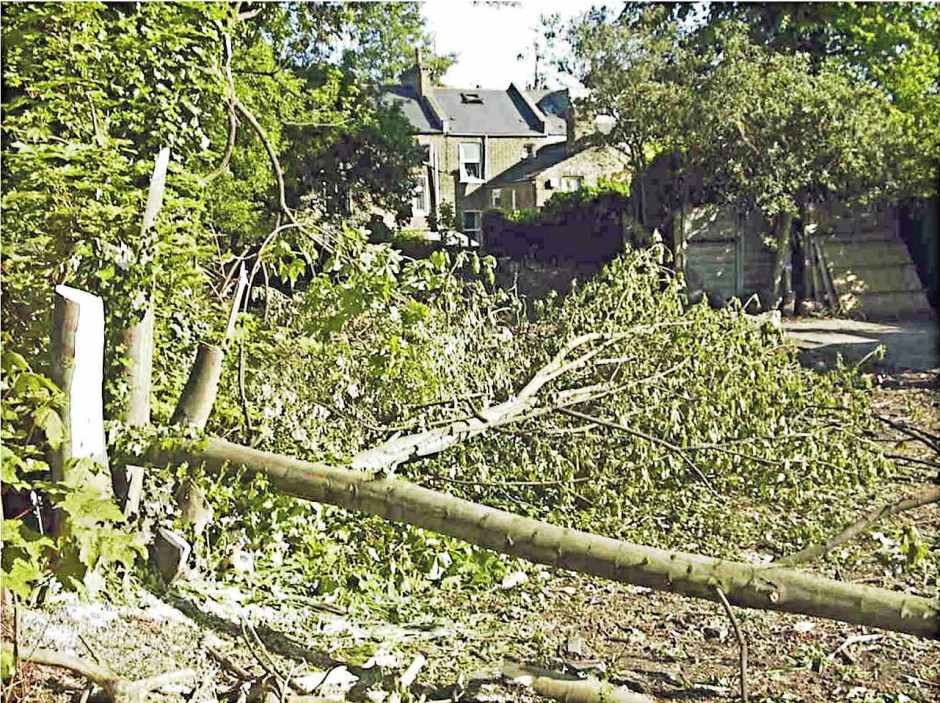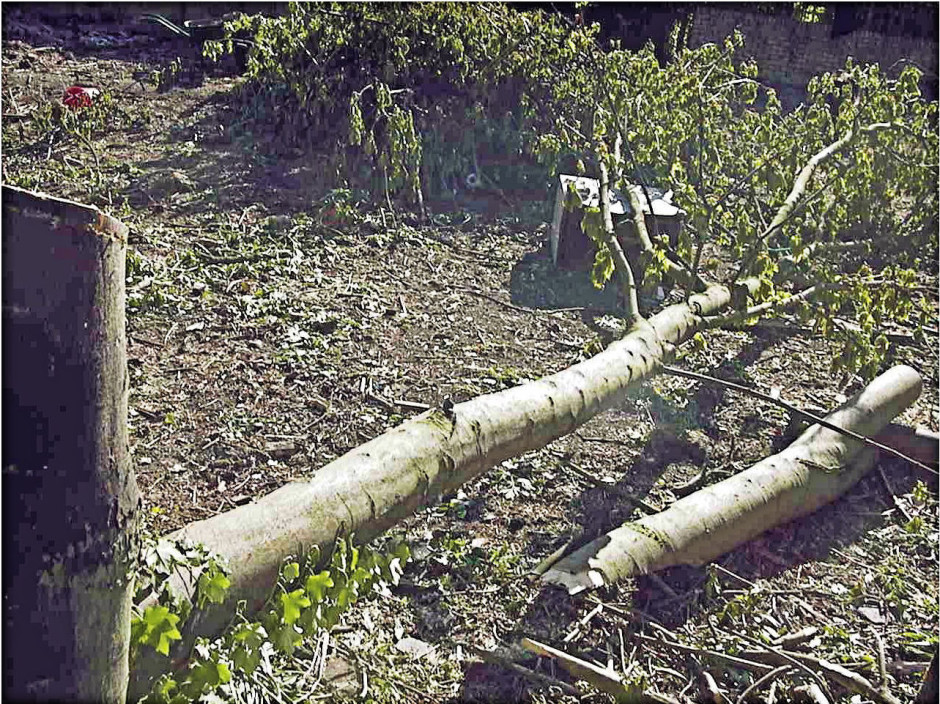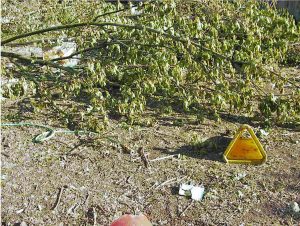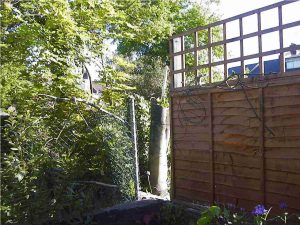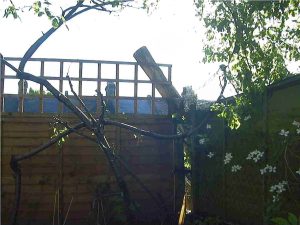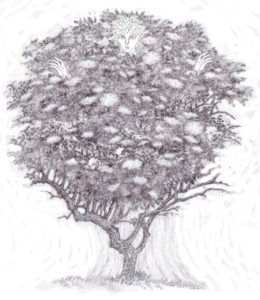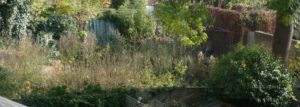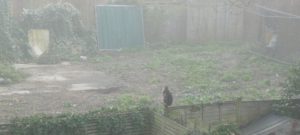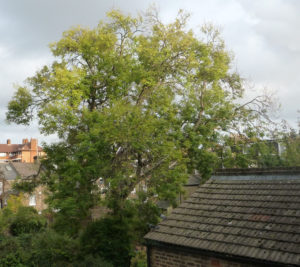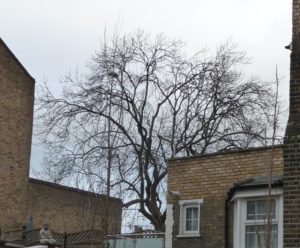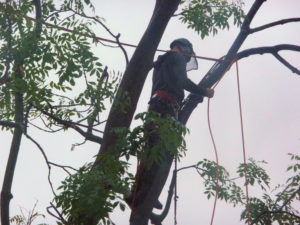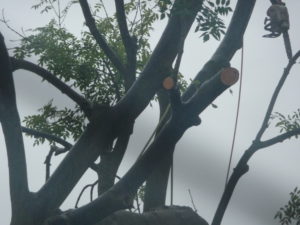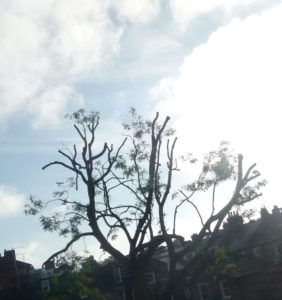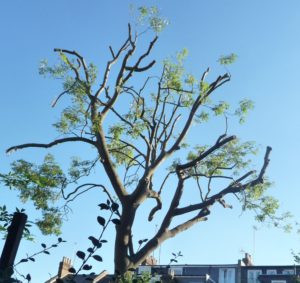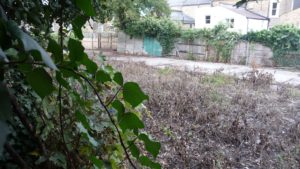Wildife has passed through our urban garden in the Highbury district of North London for years. Because of a steady loss in UK biodiversity, we try to add to what the garden can offer the wildlife.
Gardens can help bring back the bees, feed the birds & counteract urbanization. Even a windowbox, filled with wildlife-friendly plants, can make a difference. Especially if our neighbours can be doing something as well.
There was a small woodland behind our garden when I moved here in 2001. Enclosed by four streets of terraced houses, it was filled with wildlife. Mature trees – Sycamore & Elder – Buddleia, nettles, bramble & other self-seeded ‘scrub’ made a haven for many creatures. A neighbour said the dawn chorus was more like a shout… Over 12 species of bird nested there, as seeds, berries & insects were plentiful. Squirrels made their dreys in the trees & there was a fox den at one end.
The woodland grew up to the gardens’ back fences. Lavender spots in photo below ( over fence corner, top right) are Buddleia, native to China and a wildflower in the area. A number of Buddleia mounds fought for space among Sycamore & taller scrubby shrubs. The plant grows can grow quite tall when left to its own devices.
This long ginger cat, whose name we never knew, was elegant & well-mannered & we called him Mr Wonderful. He was one of many local cats who used the woodland as a meeting place. We watched from our back windows as cats climbed the woodland trees & scentmarked the paths.
There were long nose-to-nose staring contests, with one cat backing away in slow motion, deferring to the Top Cat… Yowling got louder if no-one backed down… Then, with a burst of fizzing & spitting & a flash of teeth & claws, winner & loser were decided in seconds … one cat bounding away with the other in hot pursuit.
Mr Wonderful oversaw one of these contests from the branches of a small tree near our neighbour’s back fence. As he watched the drama playing out beneath him, his body language might have been signalling ‘I’m not taking sides’…
Some cat battles spilled over into our garden, as one corner had been left unfenced. Our gardener’s potted plants took a hit most nights.
Leaves shed by trees in adjoining gardens drifted into the woodland & made leaf litter, a resource for local wildlife. The undergrowth became a dense tangle. Down the street is Gillespie Park, a managed Nature Reserve saved by neighbours from development decades ago. (See our Worth aVisit page, Gillespie Park for details.) Our tiny self-seeded woodland was biodiversity happening on its own, in the built-up metropolis that is London.
RF, our gardener, kept the area just outside of the unfenced corner cleared. There he planted Daffodil & Grape Hyacinth bulbs to join Spanish Bluebells that may have been there before WW11, when the little woodland had been market gardens. Fallen leaves in black binliners were piled behind our fence & left to become leafmould.
Around 1995 RF & Eugene had laid out paths using old rooftiles. Flower beds were long & straight. A small patio was made by the back fence, & an oval herb bed close to the house. The barrier between properties was a low brick wall topped with a chain link fence. This arrangement let in light for Eugene’s tomatoes & basil.
A few Damson trees stood in our garden, probably once contributing to the market gardens. One tree was being eaten by woodboring insects, its bark riddled with tiny holes. RF said that when all was quiet & he was having a sandwich at the white table, he could hear the chewing. That old Damson eventually collapsed & was sawn into smaller bits: the beginnings of our log pile.
Wildlife seems always to have wandered in and out of the garden through the unfenced corner. RF said that Foxes would watch him from the woodland clearing as he worked or had his lunch. Rubber balls appeared there, where vegetation was flattened. They came & went, moved by unseen forces. We assumed they had been lost by neighbours’ children who didn’t fancy climbing through nettles to retrieve them. Easier to ask mum & dad for a new one. Foxes, cats & squirrels must have got up their own ball games.
One day in spring, watching an aerial display of squirrels through the treetops, RF said ‘We don’t know how lucky we are! All this, in the heart of London!’
The little woodland disappeared unexpectedly, within a week in 2003, over a Mayday bank holiday.
At nearby Drayton Park, Arsenal Football Club was building its new stadium. We got weekly news through our mail slots from the Council, builders McAlpines & the football club… what was happening, future plans, noise levels, dust levels, how to raise an objection or apply for a job with McAlpines.
Some said the little woodland was owned by the Arsenal. Estate agent searches on behalf of new neighbours found nothing worrying about the site. In 2006, with the new Emirates Stadium done & Arsenal FC able to use it, a huge operation to pull down the old Highbury Stadium & build flats on the site began. Protests & legal objections were still ongoing; plenty to keep attention focused on the Very Large Neighbour.
To paraphrase H.G. Wells’ ‘The War of the Worlds’, ‘No one would have believed, in the first years of the Millennium, that this little plot of land was being watched keenly and closely by (!@#!!) property developers…’ It was not Martians who landed on the little woodland, but men hired by Paul Simon Developments to chop down, flatten & burn everything that lived or grew there.
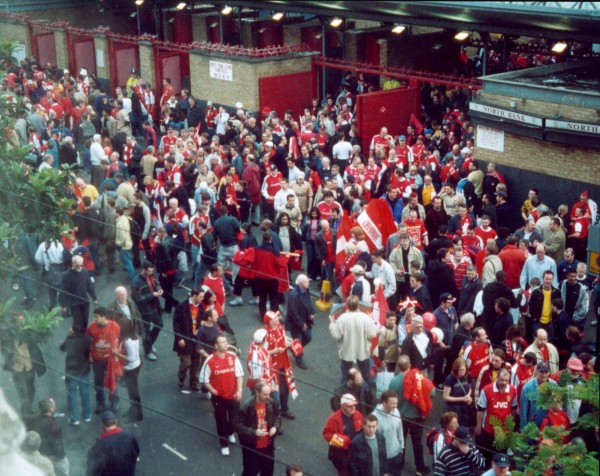 Their wrecking crew began near the entrance to the site. A lilac in bloom, spilling over its fence, was hacked away. As the men worked their way across the woodland they cut down, burned & took away whatever they found growing there.
Their wrecking crew began near the entrance to the site. A lilac in bloom, spilling over its fence, was hacked away. As the men worked their way across the woodland they cut down, burned & took away whatever they found growing there.
At nearby Highbury Stadium a sell-out crowd of 38,000 were gathering for an Arsenal Matchday. Some neighbours were on holiday. Others, at home & seeing the wood behind their gardens being trashed, tried to ring the Council. No plans had been fixed to a pole, nothing about this demolition work had come through our mail slots.
After the first day’s slashing & burning had finished, I went out to find the father Fox dead & traumatized neighbours in tears. The chopping, sawing & burning went on hour after hour for days, as the men moved inexorably towards the back of the enclosed site & the Foxes’ den.
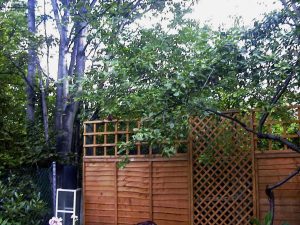 Four Sycamores growing together,
Four Sycamores growing together,before the developer
The Fox cubs were too young to leave home. But they were given no choice, as the men reached their den on Arsenal Matchday and set about demolishing it. The cubs’ only escape was into the crowd of football fans. Later, the team at the Ecology Centre said a young Fox cub had turned up at Gillespie Park; they were about to take its photo when it died. Poisoned, they said. Developers?
Neighbours were appalled and angry. Most of us only knew each other by sight, to nod & smile & go our separate ways. Now we were talking with each other, meeting up to share our frustration & rage. When asked, the men from Paul Simon Developments lied to us about what they were up to. A neighbour on Elwood Street heard the truth from one of the wrecking crew… he said that the developers had deep pockets & were prepared to wait a very long time to have their way & build on the site.
Many of us had felt safe with the overgrown woodland behind their gardens. Some had put up fencing of openwork trellis, to watch the wildlife. One couple planted cherry trees in the wild land on the other side of their back fence. They were chopped down, trashed & burned with everything else.
We met in the church hall of nearby St Thomas the Apostle & formed a group to fight the developers. This involved finding out who they were; writing letters of objection to the Council about their plans to build on the site; collecting signatures for letters of objection; getting Tree Protection Orders for four mature trees, all within adjoining gardens, all with root systems spreading into the woodland site; engaging a planning solicitor; & attending an appeal by the developers to the Department of the Environment in January 2006 & a Public Enquiry in January 2009, both held in the Council’s offices. Both appeals were rejected; the site was found unsuitable for buildings.
The Public Enquiry decision gave 34 separate reasons for rejecting the developers’ plans. Roots of the protected trees, growing in people’s gardens but known to extend out into the woodland site, were deemed important, as the Council’s tree experts showed. Digging for any building work would disturb the roots of these trees (Ash, Pear, Lime and Sycamore), all of which have TPOs (Tree Protection Orders).
” 17. As older trees are less successful in adapting to new conditions, it is particularly important in this case to respect the RPAs (root protection areas), to maintain the health of the four protected trees.’
19. The RPAs of the Sycamore… and the Lime, which are on opposite sides of the site, are very close to one another. On this evidence it would be unwise to build between the two trees. “
Our Elder tree was one of those chopped down by the developer’s crew. It was very old, & was the chosen tree for the Chief Crow’s courting dance (see Crow page, Living With North London Wildlife).
In Islington Council’s ‘FORGOTTEN FOLKLORE – MYTHS AND MAGIC IN ISLINGTON’, Richard Meyers tells of the legend of the Elder Queen, a tree spirit living within the Elder, said to visit misfortune on those who disrespect her tree. Has Paul Simon Developments or any of its operatives suffered at all since they trashed & burned our Elder?
There was talk of our writing a Midsomer Murders script, with Chief Inspector Barnaby visiting a friend in our local police force. The Chief Inspector walks out with the force as they approach the ex-woodland site, where one of the developer’s men has been found. Barnaby winces as he takes in the grisly scene. ‘But who would have had the motive to do such a thing?’ he asks. ‘Take your pick, Sir…’ says a PC… probably everyone in the neighbourhood.’
Years passed. The woodland site was sold on to another developer, and then another, and now in October there is fresh hacking and chopping and wheelbarrowing away of what had been allowed to regrow.
This amounts to demolishing a human high street, shopping mall & several playgrounds for our neighbourhood wildlife. Insects will have laid their eggs in the greenery, protein would have been available for birds & other creatures through the coming winter. As would the blackberries on the bramble bushes & the seedheads of grasses, shrubs & wildflowers. Mice living in the site’s regrown vegetation, where they were hunted by local crows, will have been driven once more into surrounding gardens & houses. Deja vu all over again.
4th December, 2015
Today new owners of the site, a firm of architects, are ‘digging trial holes with a mini-digger’, doing ‘soil investigations’. They are keen to be rid of the Ash tree, Tree Preservation Order or not.
16th December, 2016
The architects have posted letters to property owners round the site. They plan to submit new plans after the Christmas holiday. Making planning submissions close to a holiday is a developers’ tactic our neighbourhood has seen all too often. It increases the likelihood of those who might object being away from home.
The best solution for the site would be one in which it was given over to the Council’s Ecology Centre to plant with native trees & shrubs. It could benefit the environment & the community, as the nature park does.
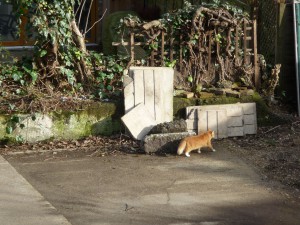
Wherever you live, if you enjoy your local trees, find out whether or not there is a Tree Preservation Order (TPO) in existence for them. If there is not, make an effort to secure one. It may not guarantee the tree’s continued existence, but it may help deter a slash-and-burn developer, or a firm of opportunist architects.
6th October 2019
Sanei Hopkins’ plans to build on the site have gone to Islington Council, and we and our neighbours have given them our objections to the plans. They have sprayed toxic chemicals on every bit of regrowth on the land (neighbours’ pets in surrounding gardens, wildlife, flowers, bees – all of no importance to them obviously). We saw the skeleton of the dead animal below after the spraying. The fox family had all been healthy.
They have had a digger in before planning permission was granted, causing one neighbour to shout out of her window that they had no right to be there, and she woulld get the police on them. They left. We await the next installment of this saga.
